

1. VAUXHALL GM2900 - CALIBRA BACKGROUND:
It was 26 years before the first post war Vauxhall Coupe model, the Firenza HC, was launched in 1971 and was an unmitigated disaster, largely because of self-inflicted decisions made by Vauxhall themselves. In October 1973, another Firenza, the droop snoot HP version, was launched and was a hugely capable & influential car but was still not a sales success - although this time through no fault by Vauxhall. At the same time in 1973, the new Vauxhall Magnum range was announced and initially included a Coupe variation using the Firenza body and despite being a very competent package was still not a sales success. A bargain priced special edition Viva E Coupe used the remaining surplus body shells after the HP Firenza & Magnum Coupe had ceased production and, ironically, was a surprising sales success. With the arrival of the Vauxhall Cavalier MK1 range in October 1975 a very attractive Coupe was included in the line-up which was later joined by the Sportshatch version which eventually supplanted the Coupe model. The Cavalier was part of the GM Europe U Car programme and their Opel counterparts were the Ascona & Manta B. When it came to planning the U Car replacement, the front wheel drive GM J82, Vauxhalls Design Department headed by Wayne Cherry had pushed hard for a both a hatch coupe and an estate model to be included in the programme. Opel, who were the lead division for the J Car in Europe, could see no need for either and in fact the only reason the Cavalier J82 Estate was ever offered in the UK was because Holden in Australia had built their own Camira Estate and the rear end parts were imported from Australia to build the Cavalier Estate. The Opel Manta was scheduled to end production at the same time as all the other U Car variations. Not for the first time, Opel’s insulated view of product planning backfired in spectacular fashion. It had been taken for granted that Ford would cease production of the Capri, the Manta & Cavalier Coupe models main rival, but instead Ford gave the Capri an extensive & very effective facelift with a planned 4-year extension to the product cycle. The talented Head of Opel Design, Gordon Brown, was charged with coming up with a cosmetic Manta facelift which needed to look dramatic, cost very little extra to manufacture and could be put in production within a minimal timeframe. In the end the Manta was also given some major mechanical enhancements including a new 1.8S OHC engine and 5 speed gearboxes. Sadly, Gordon Brown was tragically killed in a flying accident and resulted in the inevitable elevation of the even more talented Wayne Cherry, moving from Vauxhall at Luton, to become head of design for the whole of GM Europe in the ITDC at Russelsheim. Vauxhall & Opel styling would now move in a different direction.
2. VAUXHALL GM2900 - CALIBRA DESIGN & ENGINEERING:
Despite the renewed efforts from GM and Ford at breathing new life into models that were well past their sell by date the affordable coupe market across Europe was being cannibalised by the Japanese. To effectively compete against this onslaught by the major manufacturers from Japan it was clear to GM, and others, that fresh new thinking was needed for a purpose-built coupe specifically designed to compete in a sector of the market which had all but been abandoned by the major automotive players in Europe. By the beginning of 1989 the Manta, Capri, Renault Fuego & Alfa Romeo Sprint and GTV were all gone.
The replacement for the J82 Vauxhall Cavalier & Opel Ascona models was based around the new GM2900 platform and was internally coded J89 for the new Vauxhall Cavalier MK3 & Opel Vectra A. Following Wayne Cherry’s appointment, the Design Studios at the IDTC had been re-organised with greater emphasis & resources being applied to interior design, previously a well-known Opel weakness.
In March 1987 Jack Smith, head of GM Europe, was preparing for a routine visit from GM President Jim MacDonald and wanted to garner support for the Design Departments plans for a dramatically styled new Coupe with the aim of getting approval for the project. Wayne Cherry assigned the styling to Studio 3 under Erhard Schnell who had previously worked on the original Opel GT in the 60s. Under Schnell the new Coupe was designed in one week and was based on a wheelbase 3.1ins shorter than the J89 Cavalier utilising a shortened version of the GM2900 architecture with a proposed 2+2 passenger capacity. This would have matched most of the established and forthcoming opposition but, for once, cost cutting actually managed to produce a benefit. The idea for using a shortened platform was dropped in favour of using the standard GM2900 as used by the J89 Cavalier, this gave the new Coupe the unique capability of having a proper full four seat capacity which was almost unique in the affordable coupe sector of the market. In July 1987, the programme was given official approval with the internal project number 2670.

It was Schnell’s insistence to use frameless door windows which were aesthetically more pleasing, it also meant a possible future convertible version would be easier to produce. Schnell was also the main protagonist for the extremely slim headlight, fog light & turn indicator units specially developed in conjunction with Hella, they looked superb but their performance proved less than satisfactory in use. The first styling mock-up used twin front air vents which were meant to acknowledge the link with the previous Opel Manta but these were dropped in favour of a single item as it looked better. At the rear the slanted rear tail lights blended with the integrated rear spoiler design.
Wayne Cherry was renowned at Vauxhall for designs that combined striking styling with exceptional aerodynamics, Cherry was always fully involved in the fine details that could make such a difference. Unlike Vauxhall, at the ITDC Cherry had a fully-fledged aerodynamics advocate already in place – Hans-Joachim Emmelmann - but also unlike Vauxhall, Emmelmann was part of the Engineering team not the Design Department, his influence on the Calibra design was profound. He joined GM in 1979 from VW. In normal automotive practice the initial design concepts and mock-ups would record a certain aerodynamic cd factor which would then deteriorate by the time the model reached production. The initial one fifth scale Calibra design model recorded a Cd figure of 0.33 at the FKFS wind tunnel at Stuttgart University, this dropped to a stunning and record breaking figure of 0.26 for the basic version of the production model. Conventional wisdom would indicate that the biggest benefit in aerodynamics would be achieved at the front of the car, however with the Calibra the biggest benefits were achieved at the rear, the tapering of the tail gave 50% of the improvements gained, 15% from the front nose with the rest from bumpers, sills and underbody. Impressive as the Stuttgart wind tests were Emmelmann was convinced there was opportunity for further improvements by applying systematic attention to specific areas. Starting at the front, and without altering the Design Department’s basic theme, the Calibra was endowed with panel lines that didn’t disturb airflow. According to Emmelmann, the lack of flow separation was more important than just rounded corners. The careful attention to transition points between headlights & body, the grille & bonnet and by tuning the depth and width of the under bumper spoiler a very efficient nose treatment was achieved. The integrated front spoiler with its lower section in front of the tyres produced a saving of 0.01 on its own. Rounded pillars, tapered roof line, wheel arch housings and rear window were blended together to avoid vortexes that would reduce the aerodynamic efficiency. Originally, the Calibra was to be 2ins wider at the rear wheel arches and at both the top & base of the rear window. Further changes were made by moving the body waistline and rear side glass inboard from the body extremes as they move towards the rear of the car. With the rear tailgate glass at the optimum 20deg angle the Calibra assumed a droplet shape in plan-view and a true wedge in profile. The tail was also designed to impart low lift on the rear axle for greater high speed stability, in fact Vauxhall claimed that it had the same lift coefficient as cars using separate rear spoilers. Exterior door mirrors were another area that focussed attention and were designed to blend in with the front screen pillars & wings and defected water away from the side windows. A thin rubber lip running the length of the A-pillar was fitted to direct water over the roof rather than to the sides. Sealing the frameless side windows against water leaks & wind noise was accomplished a large quarter vent window and heavy rubber seals that allowed a 10mm pre-tension on the glass. At high speeds the low-pressure area on the side glass produced a tendency for the glass to be sucked out 2 to 3mm but the pre-tension allowed this to occur without any increase in wind noise. Vauxhall claimed the system was so effective that wind noise was lower in the Calibra than the J89 Cavalier with ordinary window frames. The underside was fitted with an engine shield and at the rear the petrol tank and rear bumper were merged to give an improvement of 0.005.
Vauxhall’s aim to achieve the lowest possible drag factor showed up the limitations of a normal wind tunnel in which the car is stationary and air flows around it – the revers of real life conditions. The solution was to take a prototype Calibra to the DNW wind tunnel in the Netherlands where cars were supported hydraulic cranes 2 to 3mm above a moving belt which travelled at the same speed as the wind which meant a true on road figure could be measured, this gave a further improvement of 0.005. The main priority in lowering the drag was to improve fuel consumption with an improved top speed an additional benefit, with the Vauxhall Calibra these were achieved in dramatic fashion. Emmelmann claimed that for every 0.01 improvement in CD accounted for an 0.42 gallons per 100miles reduction in fuel consumption for a combined 56/74mph cycle, with the reduction even greater at higher speeds.

Since the Vauxhall Calibra programme wasn’t given the green light until July 1987 and the planned introduction was date was late 1989 or early 1990 it was a necessity to retain as much as possible of the J89 Cavalier running gear. Cost and viability were also major factors in the decision, the Calibra was never going to sell in the same numbers as the Cavalier models and so, in order to keep the projected selling price competitive, meant using as much carry over components as possible. Any changes to the underbody design would force alterations to the manufacturing transfer lines, probably the most expensive single item in building a car, and this alone was the deciding factor to adopt the J89 wheelbase rather than the Design Departments initial preference for a shorter version.
The Engineering Department working on the development stages of the J89 Cavalier had worked hard to reduce unnecessary expenditure and came in under budget deliberately to convince Vauxhall-Opel Management that a new Coupe was not only feasible but could be done for minimal cost and a projected high return margin using savings made for J89. It also appealed on the grounds having the World’s most aerodynamic car to the Marketing Department who were keen to give Vauxhall an image of building high-tech cars at an affordable price.
Vauxhall engineers saw no reason to alter the basic MacPherson strut front suspension, although 4wd models used firmer suspension bushes and a slightly smaller 22mm instead of 24mm anti-roll bar. The trailing arm independent rear suspension of the Cavalier 4wd, which was a modified version of the Carlton MK3, was used unchanged on the Calibra 4wd. On 16v Calibra models gas filled struts were fitted all round. Power steering and 4 channel anti-lock brakes were standard on all models. In size the Calibra was 2.4inches longer than the J89 Cavalier and at 176.8ins it was longer than any of its competitors. With an overall height of 50.7ins it was 4.4ins lower than the Cavalier, the front track was identical but the rear was 0.8ins wider at 56.9inches. Compared to the Cavalier, weight increased too, the base Calibra at 2574lbs was 155lbs more, while the 4wd version weighed in at 2761lbs. Standard tyres were 195/60VR14 for the 2.0 8v, 195/60R15 for the 2.0 16v and 205/55VR15 for the 2.0 16v 4x4 models. 5.5JX14 steel wheels with plastic flush wheel covers were fitted to 2.0 8v models with the same size alloys optional. 6JX15 alloy wheels were standard on 16v versions. All models came with a 4JX15 space saver wheel with a 125/85FR tyre.
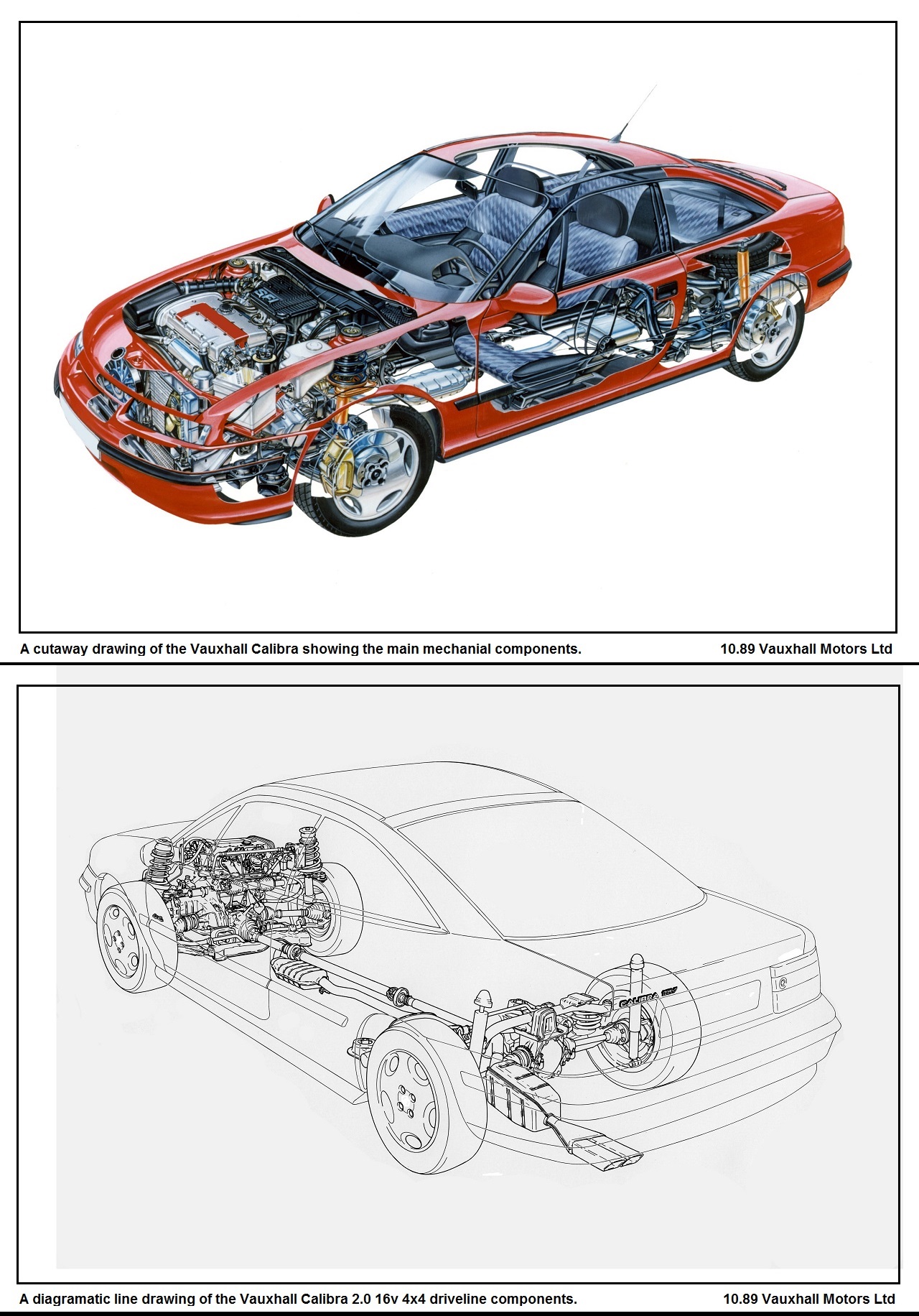
Unlike Opel, Vauxhall only offered the Calibra with engines in full catalytic form. This meant the base 2.0 8v engine produced 115bhp compared to 130bhp for the non-cat version but Vauxhall still claimed a top speed of 127mph and a 0-62mph time of 10secs. The 2.0 16v engine produced 150bhp with a top speed of 139mph and a 0-62mph time of 8.5secs, Vauxhall expected 30% of Calibra sales would be the 16v engine but this was less to do with demand and more to do with the manufacturing capacity which at launch was only 50,000 engines per year across all Vauxhall-Opel models. Major investment in production facilities quickly raised the limit to engine output. Vauxhall also announced at the Calibra launch that there were plans in place for a V6 version using a completely new engine to be built at Ellesmere Port but that it would be at least 2 years before it would be available. A 5-speed close ratio manual transmission was fitted to all three models at launch with a final drive ratio of 3.55:1 and 3.72:1 front & 3.70:1 rear for the 4wd versions. An 8.5inch clutch was fitted to 2.0 8v models with a 9.0inch for all other versions. A 4-speed Aisin AF20 automatic gearbox with winter, sport & economy modes was optional from October 1990 onwards, initially only on the 2.0 8v versions, and used a 2.70:1 final drive ratio. An oil cooler was standard on all 16v models. The 2.0 8v came with a single oval exhaust tailpipe, the 2.0 16v models were fitted with twin rectangular tailpipes.
Unusually, Vauxhall initially only offered one trim level for all Calibra models regardless of engine fitted. The only difference was the 2.0 16v models included a dashboard computer read out unit and leather covered steering wheel & gear lever knob.
Announced to the motoring press in August 1989 the first public showing was at the Frankfurt Motor Show in September where BMW were expecting to steal all the limelight with their new 850i, unfortunately GM erased the BMW from automotive memory with the Calibra which stunned the public in a way that only occurs once or twice every 10 years or so.
The Calibra was sold as a Vauxhall in the UK from May 1990 until the mid-part of 1998 although production actually ended in August 1997, as an Opel in the rest of Europe until August 1997, as a Holden in Australia & New Zealand from October 1991 until August 1996 and in Latin America as a Chevrolet from October 1992 to August 1996. Production was centred initially at Russelsheim in Germany, in 1991 Valmet Automotive added to production from their factory at Uusikaupunki in Finland. Only Vauxhall & Opel badged cars were made in Finland and from 1993 primarily V6 models, in 1995 production was consolidated and the bulk of Calibra production was centred in Finland until all Calibra production ceased in June 1997.
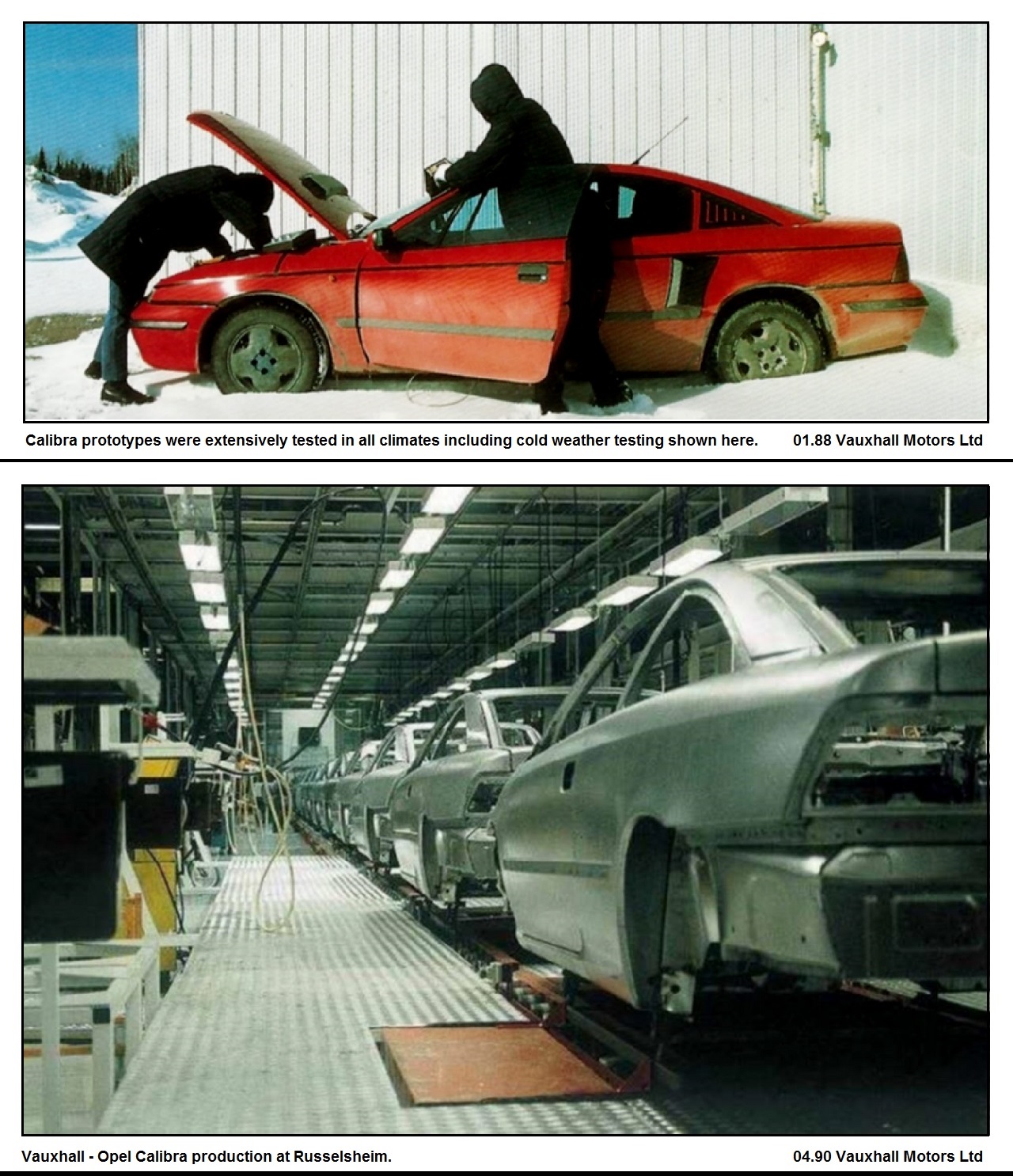

3. VAUXHALL GM2900 - CALIBRA MODEL HISTORY:
With a drag coefficient of Cd 0.26 the Vauxhall Calibra 2.0 8v retained the title of the most aerodynamic production car in the World for 10 years until the launch of the Audi A2 and Honda Insight in 1999, both with a Cd of 0.25. Ironically, all other Calibra models & all later Calibra versions had a Cd of 0.29. The Vauxhall Calibra was hailed as “possibly the most beautiful production car in the World” by Autocar & Motor magazine in 1990. While the reception given to the exterior design was universally excellent the general opinion of road dynamics and the interior, both of which were essentially standard Cavalier MK3, were either average or negative. Basically, the styling promised more than the Calibra delivered but this didn’t detract from sales. The initial estimates by GM for sales of 30,00 per year were almost immediately under estimated and initial sales exceeded production by a considerable margin.
The chassis number identification VIN number identified the
production plant where the Calibra was built
-
WOL000085[K to V] [1 or 9] XXXXXX
1 = Rüsselsheim
9 = Uusikaupunki
Vauxhalls main competitor, Ford, launched their Mazda based Probe in 1993 to counter the Calibra but the US built car never came close the Vauxhall sales success. The Rover 200 Coupe was the biggest rival in the UK. Germany, the UK, Italy, Spain and France were the largest sales markets for the Calibra.
Engines:
2.0i 8v - C20NE [LE4] 1998cc 8v SOHC 115bhp@5200rpm
125.4lb.ft@2600rpm 1990MY to 1996MY
2.0i 16v - C20XE [LJ1] 1998cc 16v DOHC 150bhp6000rpm
144.6lb.ft@4800rpm 1990MY to
1995MY
2.0i 16v ECOTEC - X20XEV [L34] 16-valve DOHC 136bhp@5600rpm
136.4lb.ft@4000rpm 1995MY to
1997MY
2.0i 16v Turbo - C20LET [LL7] 1998cc 16v DOHC Turbo 204bhp@5600rpm
206lb.ft@2400rpm 1992MY to 1997MY
2.5i 24v ECOTEC - C25XE [L80] 2498cc DOHC V6
170bhp@6000rpm 167.4lb.ft@4200rpm 1994MY
to 1996MY
2.5i 24v ECOTEC - X25XE [L80] 2498cc DOHC V6
170bhp@6000rpm 167.4lb.ft@4200rpm 1997MY
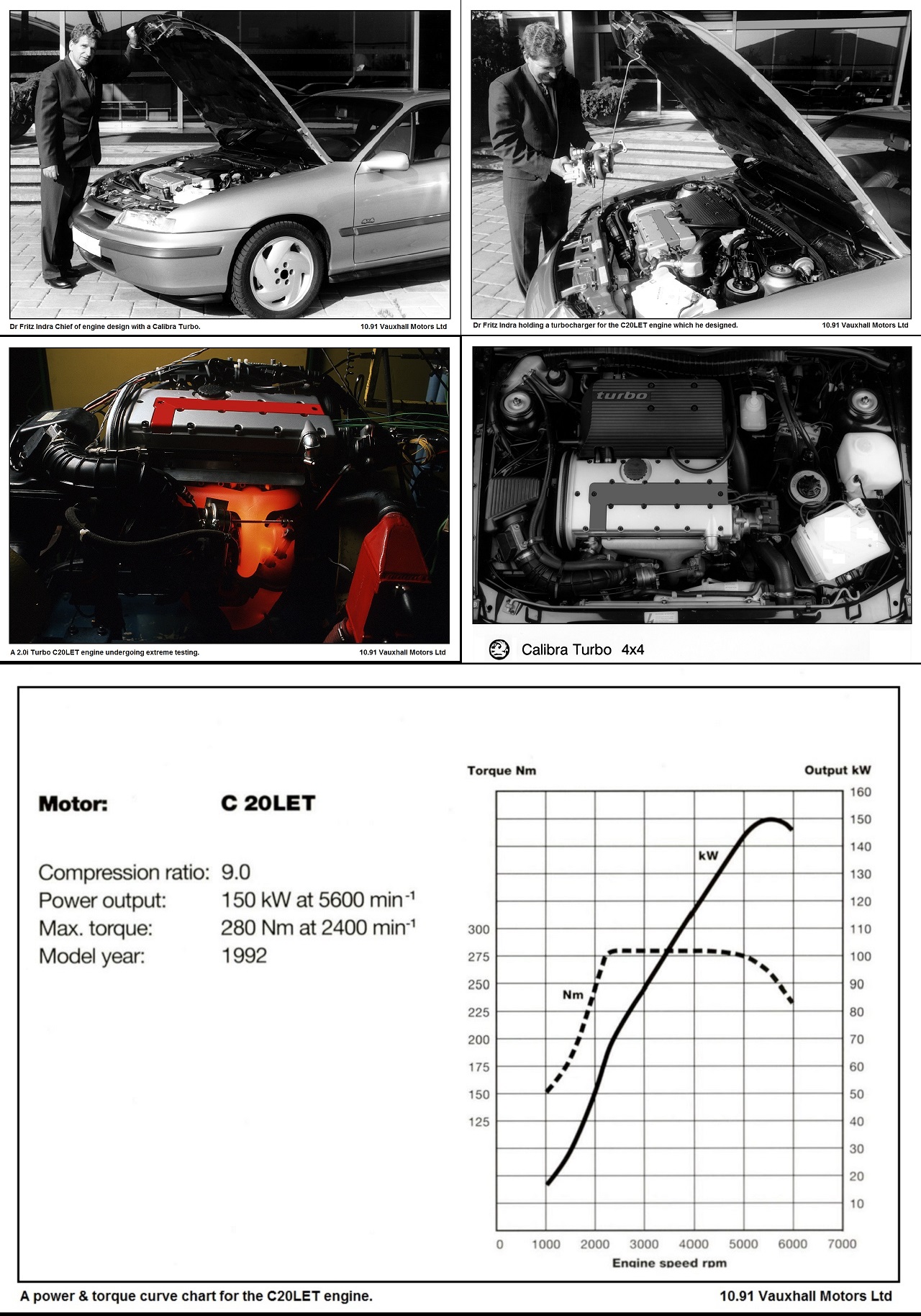
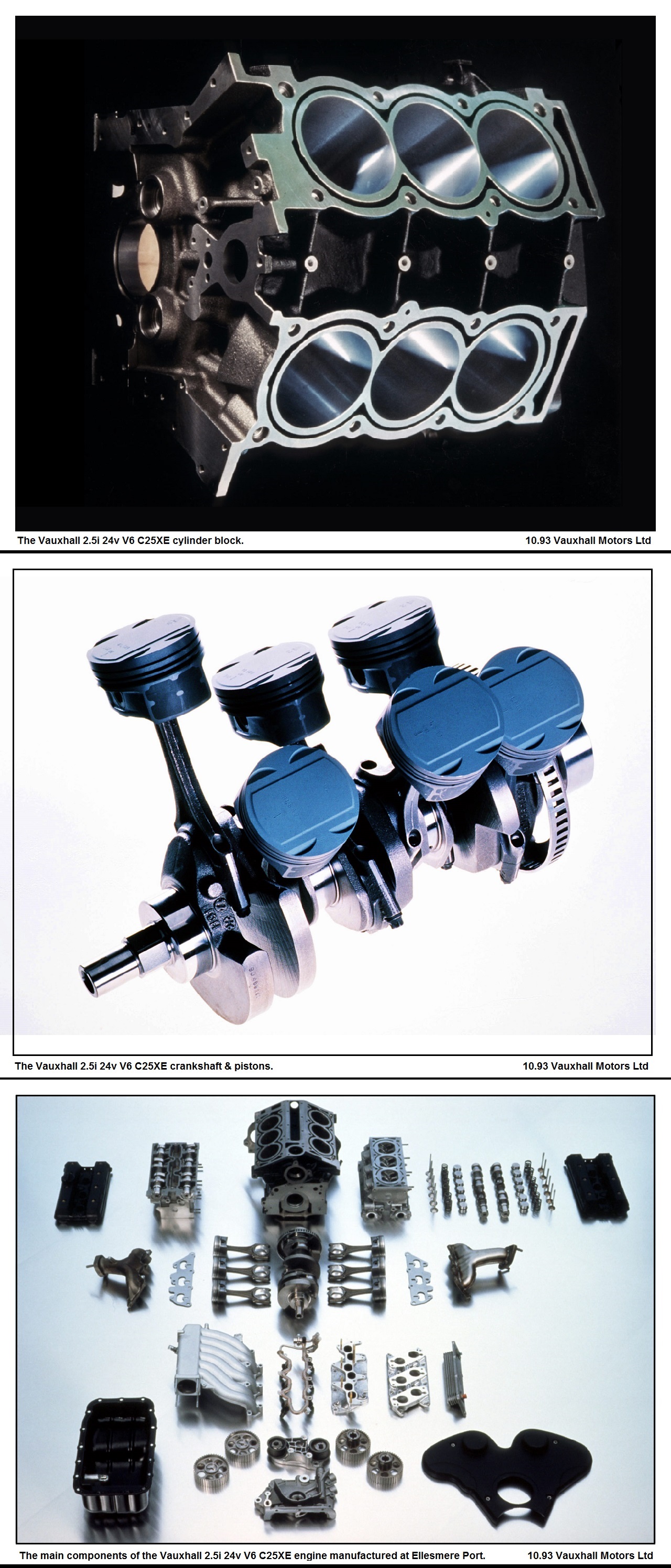
Transmissions:
Getrag F16 - 5-speed manual gearbox 2.0i 8v C20NE
Getrag F18 - 5-speed manual gearbox 2.0i 8v C20NE
Getrag F18 - 5-speed manual gearbox 2.0i 16v X20XEV
Getrag F20 - 5-speed manual gearbox 2.0i 16v C20XE
Getrag F25 - 5-speed manual gearbox 2.5i 24v C25XE X25XE
Getrag F28 – 6-speed manual gearbox 2.0i 16v Turbo C20LET
Aisin AF20 4-speed 3-mode automatic transmission - C20NE [LE4] from 10.90>
Automatic transmission not available with C20XE engine
Aisin AF20 4-speed 3-mode automatic transmission - X20XEV [LE34] from 10.94>
Automatic transmission not available with C20LET engine
Aisin AF20 4-speed 3-mode automatic transmission - C25XE [L80] from 10.93>
Aisin AF20 4-speed 3-mode automatic transmission - X25XE [L80] from
10.96>
Special
Editions:
Vauxhall Tickford Calibra - was the first limited edition Vauxhall
Calibra, it was an approved conversion and not built by Vauxhall.
Tickford were well known for producing special luxury and or
performance versions of cars from a variety of different
manufacturers. The idea behind the Tickford Calibra was to add an
element of bespoke luxury to the car, but was perhaps not exciting
enough and with the Calibra already well equipped with electric
sunroof, electric windows etc. the makeover only consisted of Alcan
Tara and Mandarin seats and interior trim, although some were later
trimmed in grey leather with red piping seats. A top-class leather
steering wheel by Italvolanti with matching leather gear shift
gaiter were fitted along with front foot-well lights, door
treadplates with Tickford engraved on them and the passenger side
cubbyhole was filled with a leather lining. Special exterior
badging on the wings & boot and Alley Cat alloys with Tickford
centres were fitted. Both the 2.0i 8v & 2.0i 16v could be
converted. The car was first shown in October 1991 at the London
Motor Show at Earls Court, 19 dealers placed orders, but the car
was not a success with only 26 built and is today extremely rare
with only a handful left on the roads.
Vauxhall Calibra SE - 1821 produced from 10.92 to 08.93 2.0i 8v. Special specification: Caribic Blue 2-coat metallic paint, 15inch 5-spoke alloy wheels & 195/60R ultra low profile tyres, Rain velour trim – leather option at a £600.00 special price, unique branded floor mats, leather trimmed steering wheel.
Vauxhall Calibra SE2 - 429 produced from 09.93 to 04.94 2.0i 16v. Special specification: Solar Yellow paint, leather interior, heated front seats, 15inch 6-spoke alloy wheels.
Vauxhall Calibra SE3 – 392 produced from 05.94 to 08.94 2.0i 8v. Special specification: Rioja two-coat pearlescent paint, special price.
Vauxhall Calibra SE4 – 907 produced from 01.95 to 06.95 2.0i 8v. Special specification: Magnetic Blue two-coat pearlescent paint, cream leather interior, heated front seats, optional 4 speed automatic transmission, 5-spoke alloy wheels & 205/55R ultra low profile tyres.
Vauxhall Calibra DTM – 05.95. 2.0i 16v ECOTEC 167 produced, 2.5i 24v V6 ECOTEC 37 produced, 2.0i 16v Turbo 25 produced. Chequers Cloth seat trim, Anthracite leather trim with heated seats optional, leather covered steering wheel with grey grip inserts, lowered sports suspension with gas pressure dampers, white 7JX16 BBS alloy wheels, 205/50R ultra low profile tyres, body colour rear spoiler with built in brake light, body colour roof rails & door handles, DTM Motorsport badging, air conditioning optional and SC804CDC stereo radio / cassette / CD player with boot mounted autochanger.
Vauxhall Calibra SE5 – 223 produced from 11.95 to 03.96 2.0i 8v. Special specification: Black two-coat solid paint, cream leather interior, heated front seats, optional 4 speed automatic transmission, lowered sports suspension with gas pressure dampers, 7JX16 BBS alloy wheels, 205/50R ultra low profile tyres, Grundig 4870 stereo radio / cassette player with 10-disc CD autochanger.
Vauxhall Calibra SE6 – 55 produced from 04.96 to 06.96 2.0i 8v. Special specification: Iceland Blue two-coat pearlescent paint, cream leather interior, air conditioning, optional 4 speed automatic transmission, 5-spoke alloy wheels & 205/50R ultra low profile tyres.
Vauxhall Calibra Turbo Limited Edition – 51 produced 08.96 2.0i 16v Turbo. Special specification: Black two-coat solid paint, body colour rear spoiler with built in brake light, lowered sports suspension with gas pressure dampers, 7JX16 BBS alloy wheels, 205/50R ultra low profile tyres, leather trim, heated seats, air conditioning, individually numbered with plaque on ashtray
Vauxhall Calibra SE7 – 489 produced from 09.96 to 12.96 2.0i 16v ECOTEC. Special specification: Magic Grey two-coat pearlescent paint, cream leather interior, heated front seats, air conditioning, 5-spoke alloy wheels & 205/50R ultra low profile tyres.
Vauxhall Calibra SE8 – 458 produced from
03.97 to 07.97 2.0i 16v ECOTEC. Special specification: Magnetic
Blue two-coat pearlescent paint, Anthracite Lens cloth trim
interior, air conditioning, body-colour rear spoiler, optional 4
speed automatic transmission, F-Line 5-spoke alloy wheels &
205/50R ultra low profile tyres.
Vauxhall Calibra SE9 – 301 produced from
05.97 to 07.97 2.5i 24v V6 ECOTEC. Special specification: Flame Red
paint, Anthracite Leather trim interior, heated front seats,
body-colour rear spoiler, optional 4 speed automatic transmission,
7JX16 BBS alloy wheels, 205/50R ultra low profile
tyres.
The total Calibra production numbers were:
2.0i 8v models – 129,284
2.0i 16v models – 82,963
2.0i 16v Turbo – 14,019
2.5i 24v V6 – 11,898
The transfer gearbox in the 4x4 models - the same box was used in the Cavalier 4x4 was a bit flimsy and suffered damage from conditions such as minor differences in tyre wear or tyre pressure between front and rear axles. Since front and rear tyres would naturally wear at different rates in normal driving, it was necessary to swap front with rear tyres every 1,500 miles. All four tyres had to be of the same make and model, and all four tyres had to be replaced at the same time - if one tyre was damaged or punctured, the three remaining good tyres also had to be replaced. In addition, there were other maintenance requirements which were both exacting and unusual. Neglect of these points through ignorance or a misconceived attempt to save money was common, and was likely to lead to very expensive failures of the transfer gearbox.
During 1990 General Motors took a majority stake in Saab AB Sweden, in order to enhance the Saab range, especially in the US, plans were evaluated to badge the Calibra as a Saab. The costs of changes needed to meet US emission & crash regulations meant the project was dropped.
A Calibra convertible was also planned in 1992 and two roadgoing prototypes were built by Valmet Automotive in Finland with an additional body shell for flexibility stress testing. The proposed selling price was considered to be too high for the project to be a viable commercial proposition and the project was dropped.
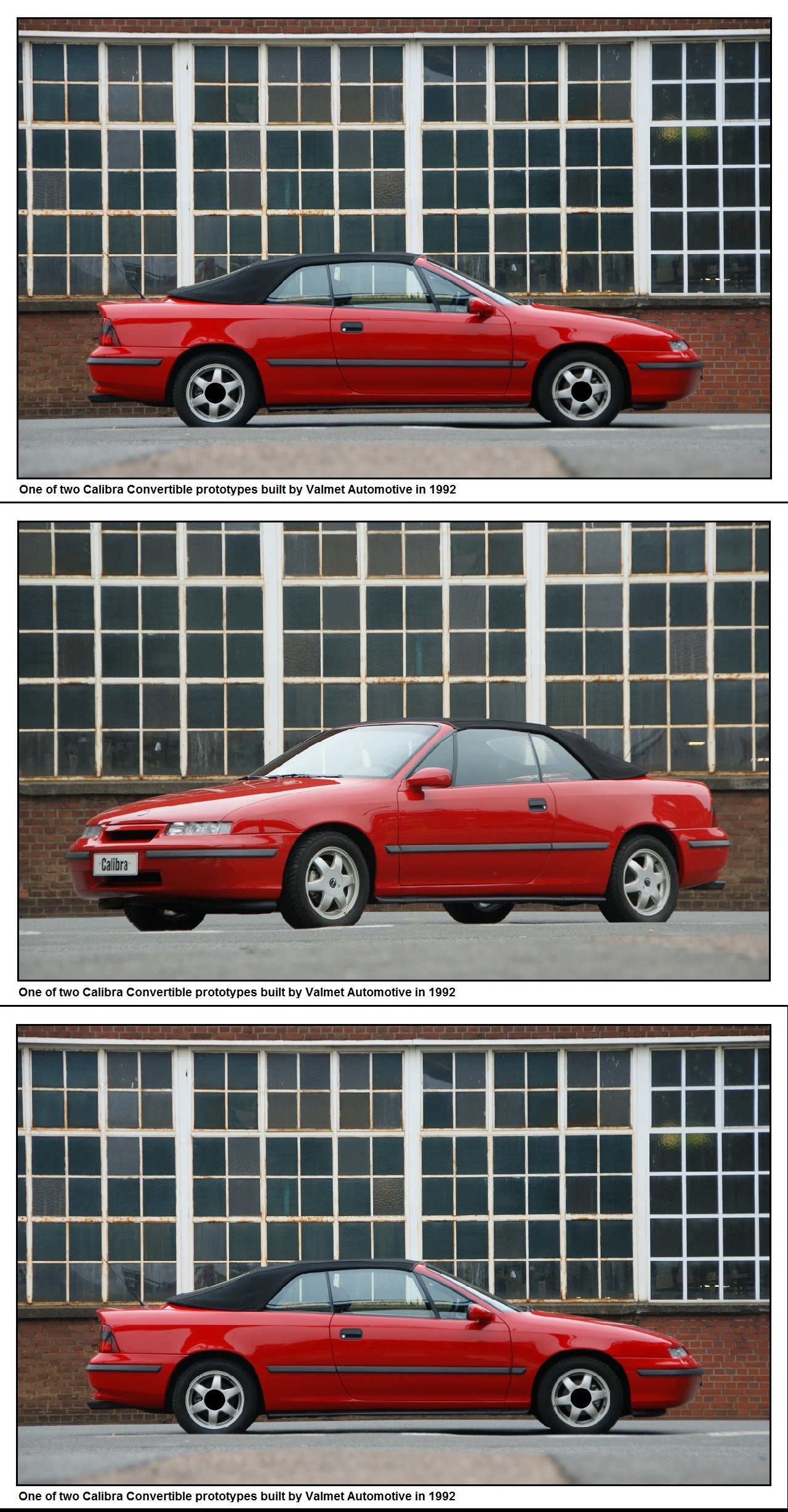


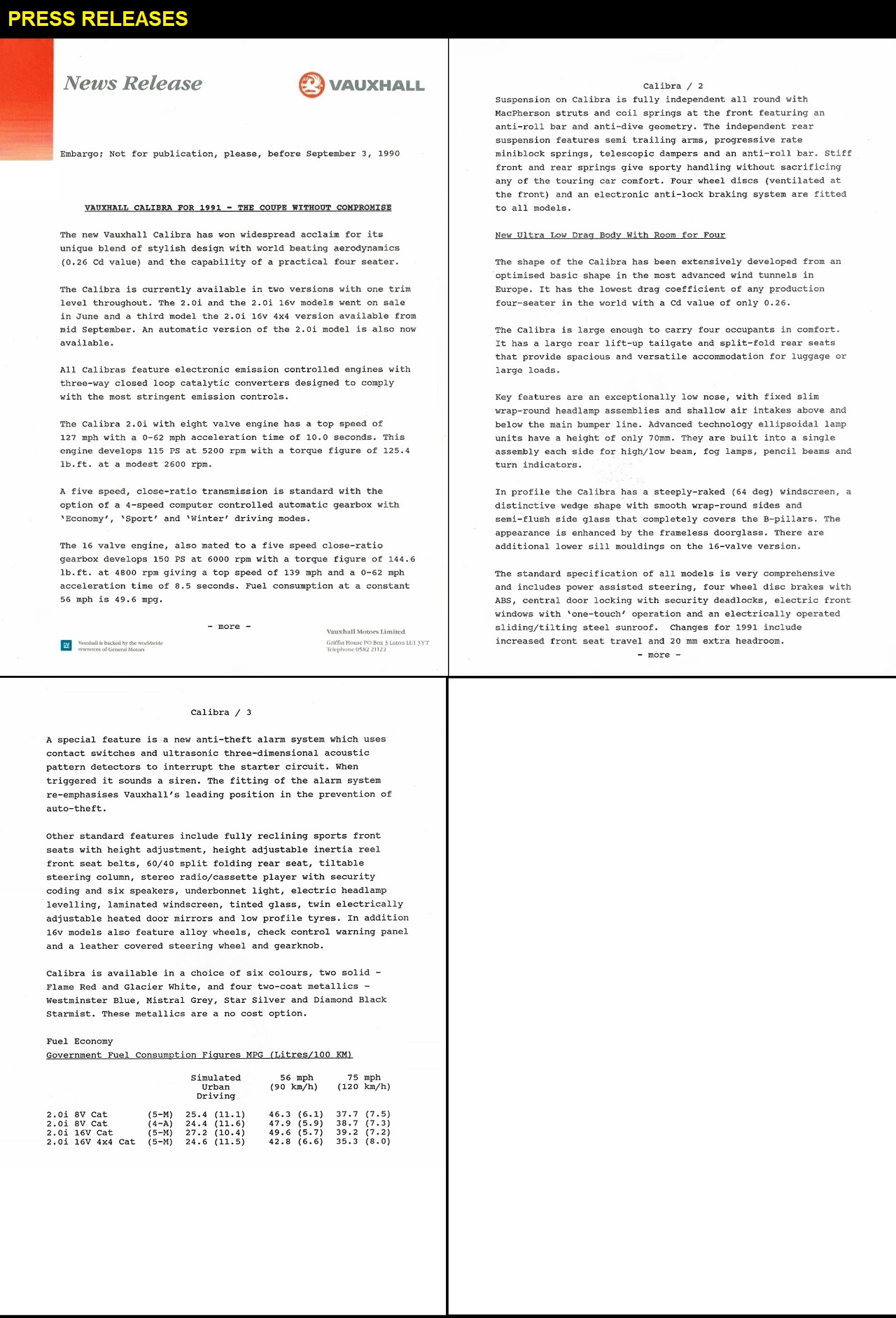
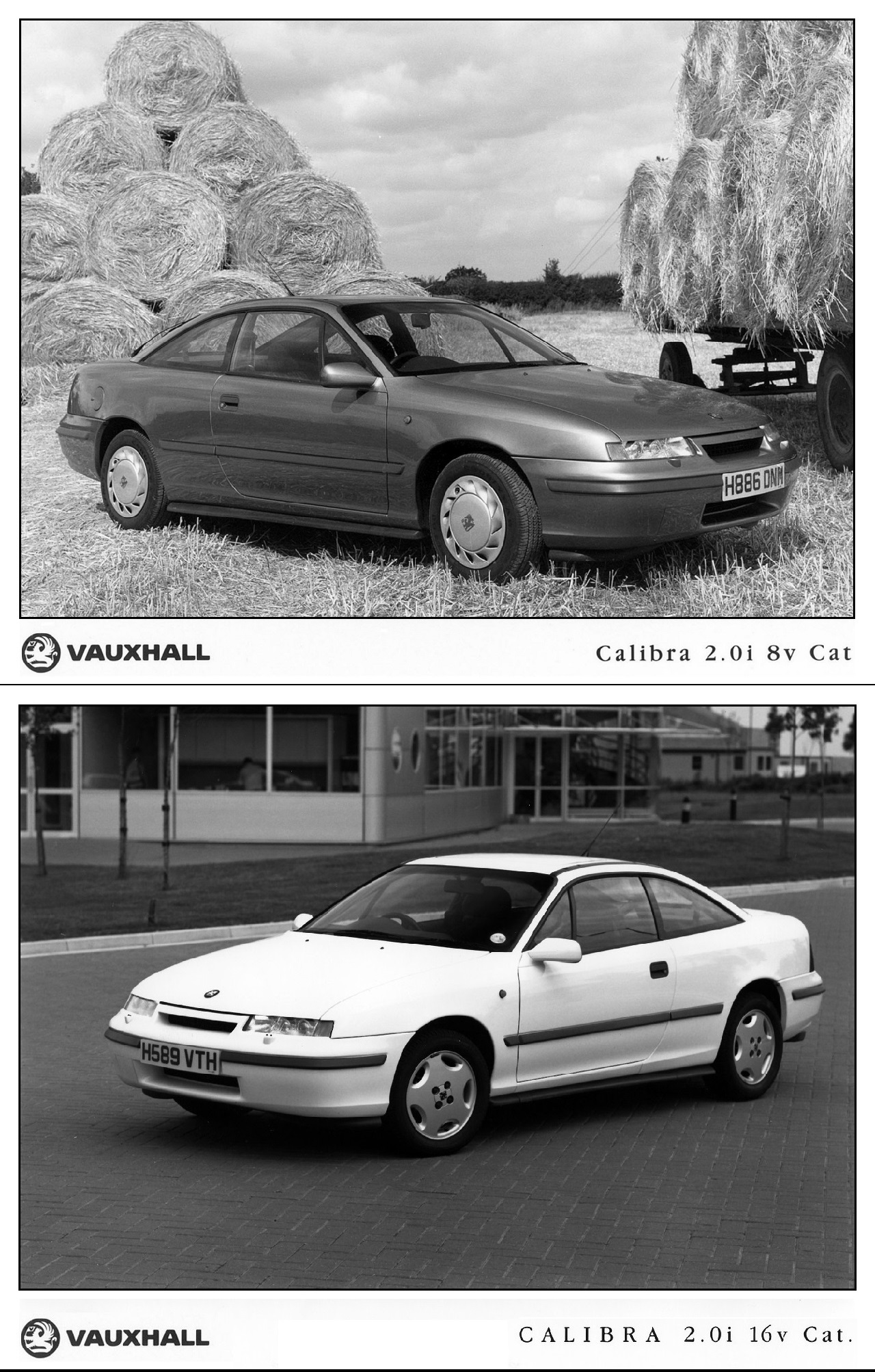
1990MY PRESS PHOTOGRAPHS:
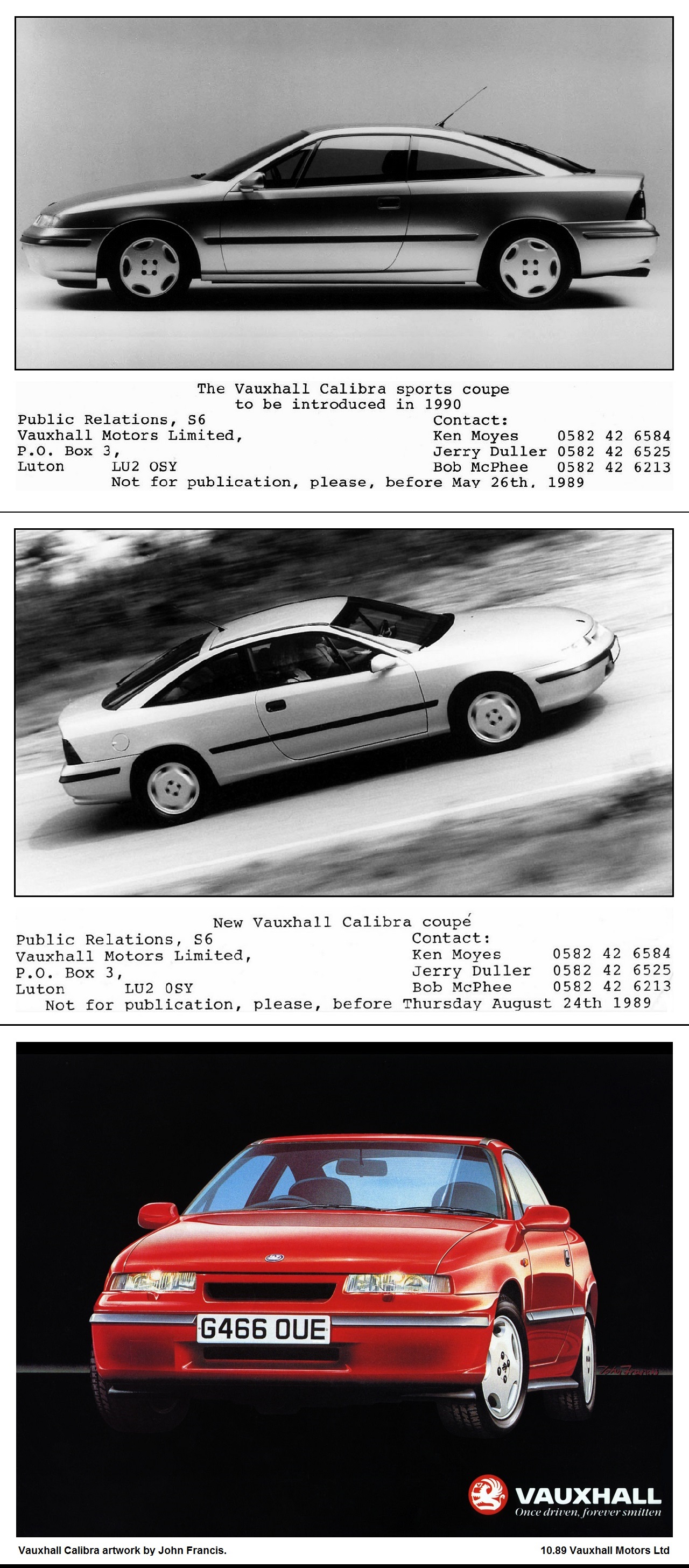

1991MY PRESS PHOTOGRAPHS:
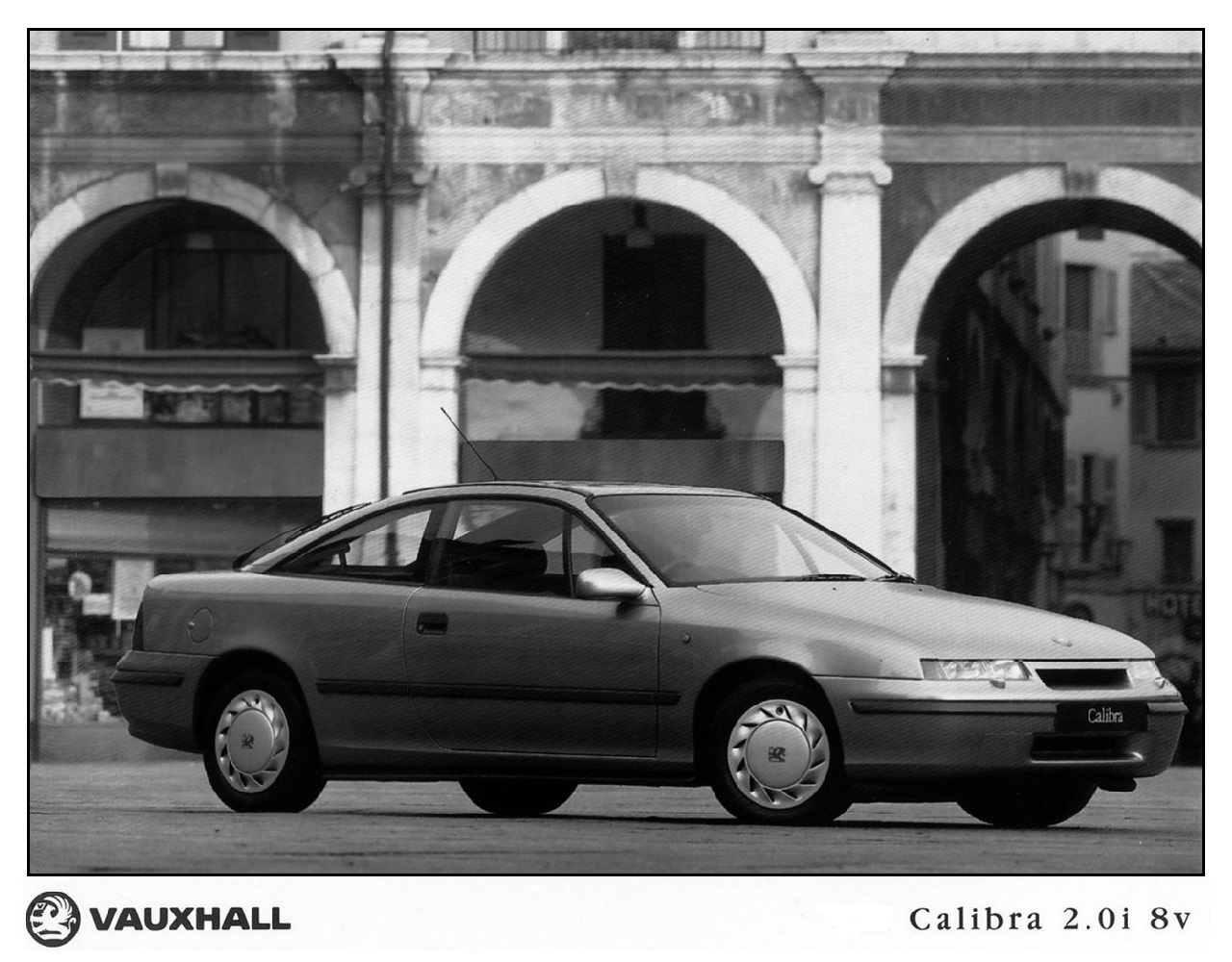
1992MY PRESS PHOTOGRAPHS:

1993MY PRESS PHOTOGRAPHS:
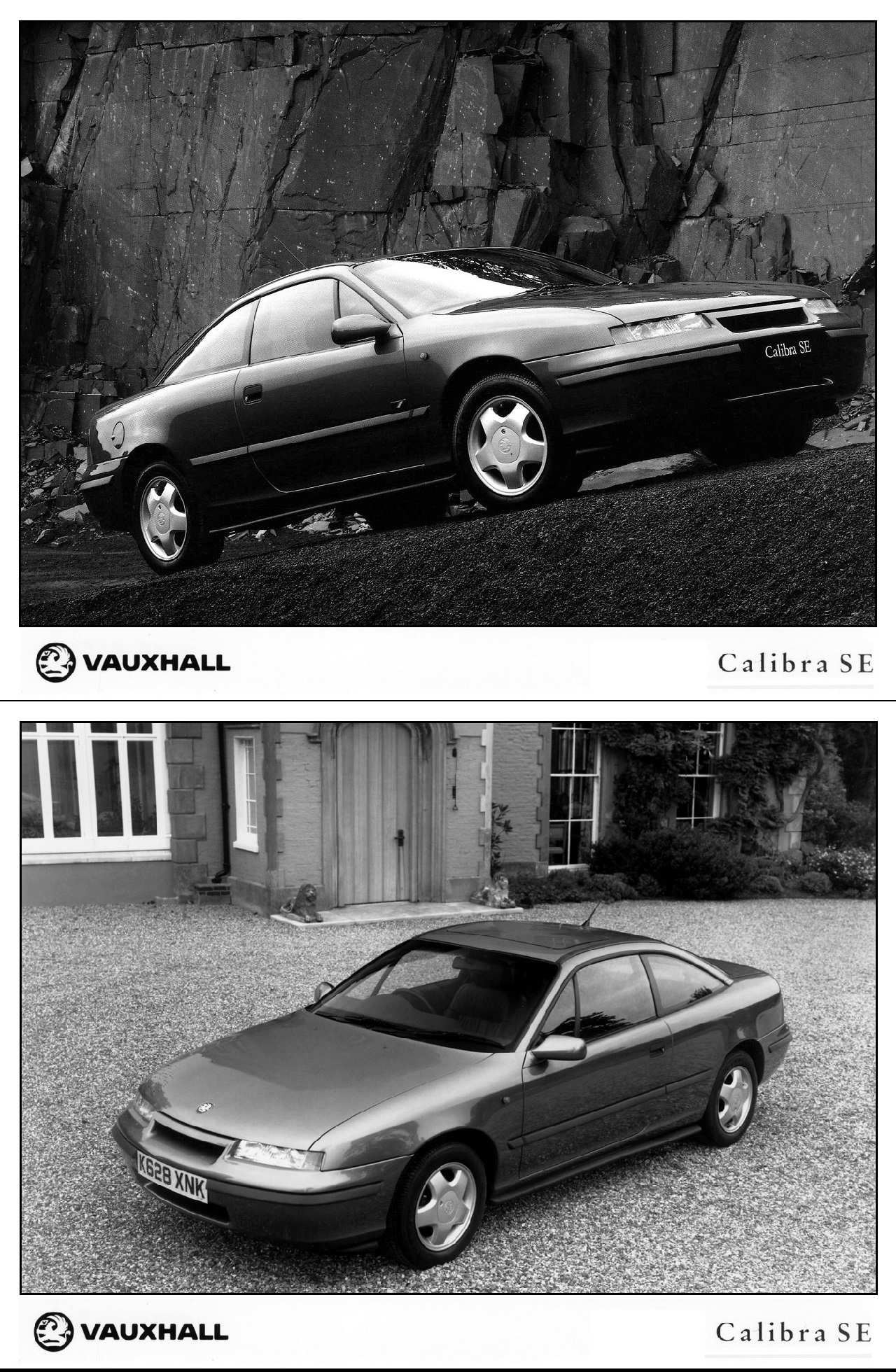
1994MY PRESS PHOTOGRAPHS:

1995MY PRESS PHOTOGRAPHS:

1996MY PRESS PHOTOGRAPHS:

1997MY PRESS PHOTOGRAPHS:
